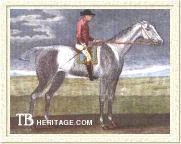Curwen's Bay Barb was foaled c.1690, and imported from France in 1698 by Henry Curwen of Workington in Cumbria, in Northern England. The horse had been sent as a gift (one of several stallions) to the French King Louis XIV by Muley Ishmael, the King of Morocco. A second horse in this same lot was the Thoulouse Barb, also brought to England by Mr. Curwen.
Famous enough in his own right to be referred to as "the Bay Barb", this stallion also went by the alias of Pelham's Barb. It is suspected that, because Henry Curwen was a Roman Catholic, to avoid having his property seized (as it was illegal at the time for Catholics to own horses over a certain value), he sent his Bay Barb to Brocklesby Park in Lincolnshire, the stud of his close friend, Charles Pelham. Many of his most important offspring are out of mares by Old Spot, a stallion owned by the Curwen/Pelham partnership. A copy of a portrait, painted when the noted stallion was 12 years of age, shows a bay horse with a blaze. The Bay Barb was said to have died at the remarkable age of 38.

Brocklesby Betty, a great racing daughter

Creeping Molly, another top racer
| | The Curwen Bay Barb was a pre-eminent sire of runners, and first among his get was Mixbury, also known as the (Minshull's) Mixbury Galloway. A bay colt foaled in 1704 out of the famous Old Spot mare, he stood a mere 13.2 hands. Mixbury had limited influence as a stallion, and his most important offspring seems to have been an unnamed daughter, the second dam of Chesnut Ranger.
The Bay Barb's best stallion son was undoubtedly Hip, who sired the stallions Hartley's Roan Horse, and Grantham, besides several useful broodmares. Another son of the Bay Barb was Blossom, and a Brother to Mixbury sired Little Bowes. There is some evidence to indicate a son of the Curwen Bay Barb, owned by Charles Pelham, was the Alcock Arabian.
The Curwen Bay Barb also sired Tantivy (a galloway), besides Brocklesby, Brocklesby Betty (ancestress of Gimcrack), Whiteneck, Sparkler, Lightfoot, Creeping Molly, Westbury, Little George, and the Ringtail Galloway (the latter out of a daughter of Hip). He also sired the dams of Monkey, Hazard, Jew Trump, Sloven, Goliah, Sophonisba, and Halifax, and the second dam of Engineer. There were also two sisters to Mixbury, one of which produced Quiet and Sloven, the other produced Soreheels, Miss Jigg, and the extremely influential (Old) Partner. |
The term "galloway" seems to have been applied alternately as a strain of small, fast horses bred in Britain, similar to the Irish Hobby, but presumably derived from the galloway or Galway area in Scotland, or to label any small running horse carrying lighter weights, of native or of oriental breeding. The Mixbury Galloway's dam was by Old Spot (by the Selaby Turk-unknown mare) out of a mare by the White-Legged Lowther Barb, from the Old Vintner Mare (by Curwen's Arabian-an unknown mare). There are only two possible non-Oriental horses in this pedigree, the two unknown mares, and either or both of these could have been of native extraction, especially since both were from studs in the northern reaches of England, galloway territory. The overwhelming number of galloways identifed with the Curwen Bay Barb indicates that either he was a particularly small stallion that sired the same, or that he was bred to many mares of native British breeding, which would have been likely in Cumbria, bordering, as it does, on the Scottish counties of Dumfries and Galloway. It is noted that he did not cover many mares except for those of the partners, Curwen and Pelham.
Notes on color and markings of the Curwen Bay Barb. The Curwen Bay Barb was a bay with a blaze, and since it's much more common to see such extensive white markings on a chestnut rather than on a bay or brown, it's possible that this stallion was a sabino or rabicano carrier. Descriptions of several of his immediate descendants hint that he passed on some unusual color genetics, especially white modifiers. The Ringtail Galloway's name is intriguing as the term "ringtail" is used to describe the genetic condition referred to as "rabicano", believed to be related to the sabino gene. The presence of the Rabicano gene is characterized by some roaning (a non-fading mix of white and colored hairs) on the flanks, set off by the classic ringtail (or skunktail) markings, one or two bands of white hairs at the root of a normally-pigmented tail. This coloration is often seen with horses with extensive white markings. Since the Ringtail Galloway was inbred to the Curwen Bay Barb (1x3, being out of a daughter of Hip), it's possible he would inherit some of the unusual color genes the Curwen Bay Barb may have possessed. The Curwen Bay Barb's grandson, (Old) Partner, was a golden chestnut with a blaze and hind stockings, classic expressions of the Sabino gene. This gene or gene combination expresses itself with varying degrees of irregular white markings and/or white hairs in the base coat. Offspring of so-marked horses may have excessive white markings such as leg markings extending over the knees and hocks, white belly-splashes, and varying degrees of roaning on the main body.
--Anne Peters
|

